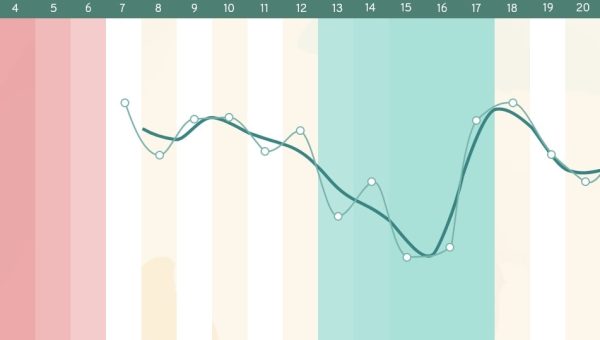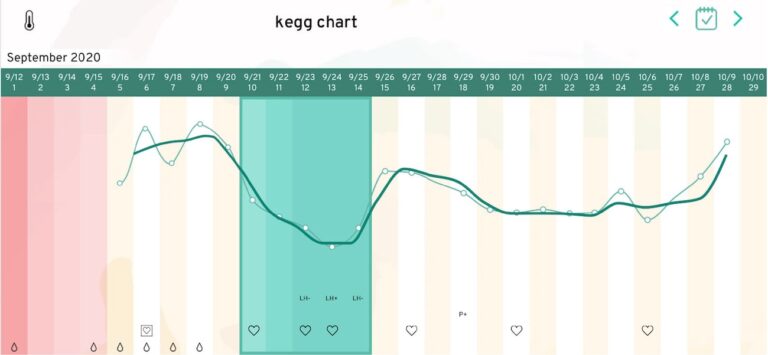kegg is an intuitive 2-in-1 fertility tracker intended to detect a woman’s fertile window and possible ovulation up to 7 days in advance.* kegg senses electrolyte changes in vaginal fluids, so it is as precise as your body. In about 2 minutes of use each day, you’ll be able to track your unique cycle in real-time and optionally, exercise your pelvic floor through the kegel training feature.
How does it work?
Through advanced sensing technology known as impedance, kegg measures changes in the electrolyte levels of cervical mucus.

Fun fact: Cervical mucus is full of minerals and metals like sodium, potassium, calcium, magnesium, zinc, copper, and iron. These elements make up the electrolyte structure of cervical fluid and the concentration changes throughout the cycle.
When it comes to fertility, two main hormones take center stage: estrogen and progesterone. As a woman’s body prepares for ovulation and enters the fertile window, estrogen levels begin to rise, as seen in this graph below:

This surge in estrogen triggers the cervix to secrete cervical mucus (sometimes referred to as cervical fluid). What does this cervical fluid have to do with conception? Actually, a lot! Cervical mucus plays a vital role in conception, as the survival of sperm is dependent on the presence of fertile cervical mucus. Sperm can be nourished for up to 5 days with the help of cervical fluid. Women typically have the most fertile cervical fluid 2–3 days before ovulation, when a woman has the best chance of conception. (1)
kegg senses the electrolyte levels which correlate to the hormonal fluctuations throughout the cycle. There is a shift to progesterone production once the egg is released, which results in a change in the electrolytes in the cervical mucus. There are several days in which mucus is more fertile in quality leading up to ovulation. Unlike temperature tracking methods and LH testing, kegg predicts these fertile days in advance, empowering women to identify when they are potentially fertile.

Above is a chart depicting kegg readings from a kegg user. kegg’s algorithm assesses the trends of your test results over time to predict when your fertile window will occur. In your first cycle with kegg, the app will place a predicted fertile window based on your selected cycle length.* This fertile window is displayed as 5 green days in the cycle view and your daily predictions are labeled as “Low”, “Possible”, or “Likely” depending on your cycle day. This green prediction window may move during your cycle based on your trend line. With each new cycle completed, kegg will learn your unique fertility patterns and more precisely place its fertile window prediction.
While every woman has a unique trend, as electrolyte compositions are individual, the fertile window typically follows a general pattern. The fertile window is often depicted as a “valley” or a “dip” followed by a rise in kegg data. This downward descent typically correlates with increasing estrogen levels as a woman approaches ovulation. In the example chart above, the fertile window “valley” falls between cycle day 13 and cycle day 17. Note the rise on cycle day 17. This increase occurs as a result of the electrolyte changes that occur with rising progesterone after ovulation. While some women appreciate a significant valley or dip, others have smaller, more subtle changes. Fortunately, kegg detects even these small changes and is able to formulate its fertile window prediction based on the data it records.
After the fertile window, kegg readings may stay elevated, or may continue to have dips or valleys. Unlike with basal body temperatures, kegg readings do not need to remain elevated throughout the luteal phase.
At the completion of your chart, kegg will place an estimated 5 day fertile window based on your kegg data for that completed cycle. No consumer device can confirm ovulation with 100% accuracy, and therefore kegg can only suggest when ovulation might have occurred.

If you struggle to track your fertile window because of irregular cycles (like many women do), kegg can give you insights about your unique cycle. *If your cycle length is longer than 40 days or shorter than 21 days, kegg will not place a fertile window prediction. To learn if kegg would be a good fit for you, please see our FAQ page.
Why is it important to test at the same time daily?
Electrolytes fluctuate greatly throughout the day. kegg’s algorithm is looking at the overall cycle patterns based on readings taken roughly every 24hrs. For consistency, testing with kegg at the same time within a 2 hour window is crucial. For example, if you choose to test at 8 PM every evening, the two hour window in which testing should occur is from 7 to 9 PM. If for some reason you cannot test on a given day, it is best to skip testing for that day, as testing outside of your testing window will likely skew your data.
How will intercourse impact my kegg readings?
Semen, arousal fluids, lubes, jellies, etc. can impact your kegg readings as they all contain electrolytes. For this reason, it is important to not test in the 8 hours after intercourse.
How is the kegg graph different from a basal body temperature graph?
When tracking your basal body temperature (BBT), a temperature shift mid-cycle typically signifies ovulation has occurred. You can likely assume that the days leading up to this temperature surge were your fertile days; however, this is of limited benefit after the fact when you’re trying to conceive because you might miss your most fertile days prior to ovulation. Read about how kegg data compares to the Sympto-Thermal Method here.
With kegg, users are able to see real-time data daily, so there is no guessing. During the daily test, kegg uses low-level electrical pulses to sense the electrolytes present in the cervical mucus. The daily reading is then plotted on your kegg chart. In addition to the green fertile window prediction, kegg users are able to see their trend line and are able to see their fertile window happening in real-time. This objective reading allows for a more accurate fertile window prediction in comparison to cycle tracking apps and counting methods. Every woman’s cycle is unique. The old school rule of “you ovulate on day 14 and have a 28-day cycle” just isn’t true for everyone, and relying on that can skew your chances of conception.
Knowing your fertile window maximizes your chances of natural conception, and kegg is here to bring you a convenient solution for stress-free fertility tracking.

